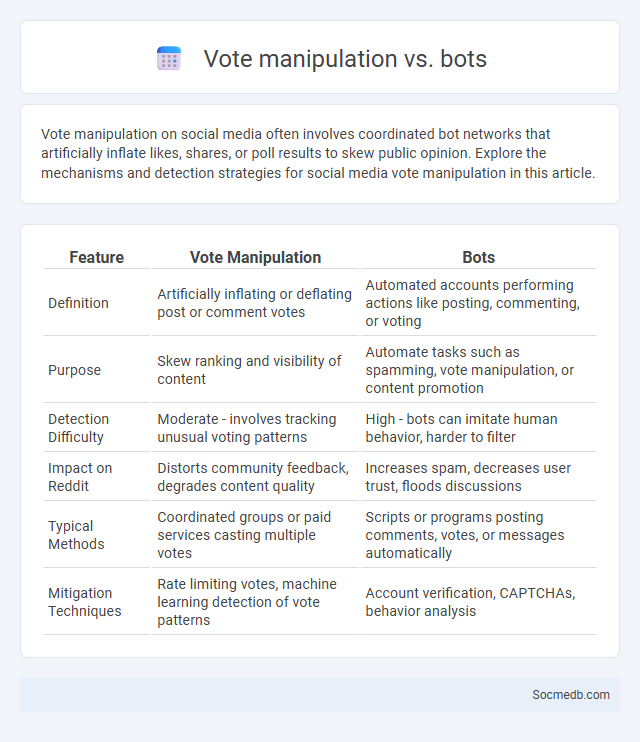
Photo illustration: vote manipulation vs bots
Vote manipulation on social media often involves coordinated bot networks that artificially inflate likes, shares, or poll results to skew public opinion. Explore the mechanisms and detection strategies for social media vote manipulation in this article.
Table of Comparison
| Feature | Vote Manipulation | Bots |
|---|---|---|
| Definition | Artificially inflating or deflating post or comment votes | Automated accounts performing actions like posting, commenting, or voting |
| Purpose | Skew ranking and visibility of content | Automate tasks such as spamming, vote manipulation, or content promotion |
| Detection Difficulty | Moderate - involves tracking unusual voting patterns | High - bots can imitate human behavior, harder to filter |
| Impact on Reddit | Distorts community feedback, degrades content quality | Increases spam, decreases user trust, floods discussions |
| Typical Methods | Coordinated groups or paid services casting multiple votes | Scripts or programs posting comments, votes, or messages automatically |
| Mitigation Techniques | Rate limiting votes, machine learning detection of vote patterns | Account verification, CAPTCHAs, behavior analysis |
Understanding Vote Manipulation: Key Concepts
Vote manipulation on social media involves tactics like bot usage, fake accounts, and coordinated voting campaigns to artificially influence polls or content rankings. Platforms employ algorithms and machine learning techniques to detect irregular voting patterns and maintain authentic user engagement. Recognizing these manipulative behaviors is crucial for ensuring fair online interactions and protecting the integrity of digital polls.
What Are Bots? Automation in Voting Systems
Bots are automated software programs designed to perform tasks on social media platforms, such as creating content, liking posts, or following users. In voting systems, automation through bots can manipulate public opinion by generating fake engagement, amplifying certain messages, or skewing poll results. Identifying and mitigating bot activity is crucial to maintaining the integrity and accuracy of online voting and social media analytics.
Vote Manipulation vs Bots: Exploring the Differences
Vote manipulation exploits algorithmic vulnerabilities by artificially inflating engagement through coordinated human or automated actions, aiming to skew public opinion or election outcomes. Bots operate as automated software programmed to simulate human behavior, generating false votes or interactions at scale without genuine user consent. Understanding the distinction between intentional vote manipulation tactics and automated bot activities is crucial for developing effective detection and prevention strategies in social media ecosystems.
Techniques Used in Vote Manipulation
Vote manipulation on social media platforms often involves techniques like coordinated bot activity, fake accounts, and automated upvoting or downvoting to artificially inflate or deflate content popularity. Algorithms can be exploited through targeted hashtag campaigns and mass reporting to skew visibility in trends or search results. Understanding these tactics helps Your awareness of how digital public opinion can be distorted on networks such as Twitter, Facebook, and Reddit.
How Bots Influence Online Voting
Bots manipulate online voting by artificially inflating votes and skewing poll results, undermining the authenticity of public opinion. Your ability to gauge genuine sentiment is compromised when automated accounts flood platforms with coordinated responses designed to influence outcomes. Effective detection and mitigation strategies are crucial to preserve the integrity of social media voting mechanisms.
Identifying Signs of Vote Manipulation
Unusual spikes in follower counts, repetitive or identical comments, and coordinated posting patterns often indicate vote manipulation on social media platforms. Monitoring engagement metrics such as sudden surges in likes or shares from suspicious accounts can help you detect these signs early. Recognizing bot-like behavior and inconsistent user activity enhances your ability to maintain authentic interactions and safeguard online voting processes.
The Impact of Bots on Poll Credibility
Bots significantly undermine the credibility of social media polls by artificially inflating or deflating results, leading to skewed data that misrepresents genuine public opinion. These automated accounts often manipulate poll outcomes through mass voting and coordinated behavior, creating a false perception of consensus or dissent. As a result, reliance on social media poll data without rigorous bot detection and filtering can severely compromise the validity of public sentiment analysis.
Detection Strategies for Bots and Vote Manipulation
Detection strategies for bots and vote manipulation on social media leverage machine learning algorithms to analyze behavioral patterns, such as rapid posting frequency and unnatural interaction ratios. Advanced natural language processing techniques identify automated or scripted content, while network analysis maps suspicious activity clusters indicating coordinated manipulation. Real-time anomaly detection systems continuously monitor voting trends to flag irregular spikes that suggest fraudulent influence campaigns.
Combating Vote Manipulation: Best Practices
Effective strategies for combating vote manipulation on social media include deploying AI-powered algorithms to detect suspicious voting patterns and employing CAPTCHA systems to prevent automated bots from skewing results. Regular audits and transparent reporting of voting data enhance trust and mitigate the risk of tampering in online polls or contests. Encouraging user verification through email or multi-factor authentication strengthens the integrity of vote submissions and reduces fraudulent activities.
The Future of Online Voting: Security and Integrity
The future of online voting hinges on advancements in blockchain technology and end-to-end encryption to ensure security and integrity. As social media platforms integrate digital identities, they offer opportunities for transparent voter authentication and real-time election monitoring. Implementing secure, decentralized systems can significantly reduce fraud risks and increase voter participation worldwide.
 socmedb.com
socmedb.com